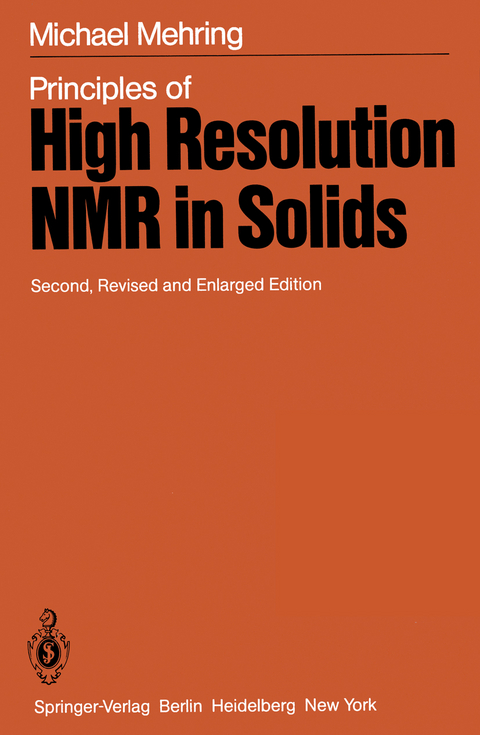
Principles of High Resolution NMR in Solids
Springer Berlin (Verlag)
9783642687587 (ISBN)
1 Introduction.- 2 Nuclear Spin Interactions in Solids.- 2.1 Basic Nuclear Spin Interactions in Solids.- 2.2 Spin Interactions in High Magnetic Fields.- 2.3 Transformation Properties of Spin Interactions in Real Space.- 2.4 Powder Spectrum Line Shape.- 2.5 The NMR Spectrum. Lineshapes and Moments.- 2.6 Magic Angle Spinning (MAS).- 2.7 Rapid Anisotropic Molecular Rotation.- 2.8 Line Shapes in the Presence of Molecular Reorientation.- 3 Multiple-Pulse NMR Experiments.- 3.1 Idealized Multiple-Pulse Sequences.- 3.2 The Four-Pulse Sequence (WHH-4).- 3.3 Coherent Averaging Theory.- 3.4 Application of Coherent Averaging Theory to Multiple-Pulse Sequences.- 3.5 Arbitrary Rotations and Finite Pulse Width in Multiple-Pulse Experiments.- 3.6 Second Averaging.- 3.7 The Influence of Pulse Imperfections on Multiple-Pulse Experiments.- 3.8 Resolution of Multiple-Pulse Experiments.- 3.9 Magic Angle Rotating Frame Line Narrowing Experiments.- 3.10 Modulation Induced Line Narrowing.- 3.11 Applications of Multiple-Pulse Experiments.- 4 Double Resonance Experiments.- 4.1 Basic Principles of Double Resonance Experiments.- 4.2 Cross-Polarization of Dilute Spins.- 4.3 Cross-Polarization Dynamics.- 4.4 Spin-Decoupling Dynamics.- 4.5 Application of Cross-Polarization Experiments.- 5 Two-Dimensional NMR Spectroscopy.- 5.1 Basic Principles of 2 D-Spectroscopy.- 5.2 2D-Spectroscopy of 13C-1H Interactions in Solids.- 5.3 Applications of 2D-Spectroscopy.- 6 Multiple-Quantum NMR Spectroscopy.- 6.1 Double-Quantum Decoupling.- 6.2 The Three-Level System; Double Quantum Coherence.- 6.3 Multiple-Quantum Coherence.- 6.4 Selective Multiple-Quantum Coherence.- 6.5 Double-Quantum Cross-Polarization.- 7 Magnetic Shielding Tensor.- 7.1 Ramsey's Formula.- 7.2 Approximate Calculations of the Shielding Tensor.-7.3 Proton Shielding Tensors.- 7.4 19F Shielding Tensors.- 7.5 13C Shielding Tensors.- 7.6 Other Shielding Tensors.- 8 Spin-Lattice Relaxation.- 8.1 Spin-Lattice Relaxation in the Weak Collision Limit.- 8.2 Spin-Lattice Relaxation in Multiple-Pulse Experiments.- 8.3 Application of Multiple-Pulse Experiments to the Investigation of Spin-Lattice Relaxation.- 8.4 Spin-Lattice Relaxation in Dilute Spin Systems.- 8.5 Selective Excitation and Spectral Diffusion.- 9 Appendix.- A Irreducible Tensor Representation of Spin Interactions.- B Rotations.- C General Line Shape Theory.- D Homogeneous, Inhomogeneous and Heterogeneous Lineshapes.- E Lineshape and Relaxation due to Fluctuating Chemical Shift Tensors.- F Time Evolution and Magnus Expansion.- G Coherent Versus Secular Averaging Theory.- H Applications of Average Hamiltonian Theory.- I Relaxation Theory.- 10 References.- 11 Subject Index.
| Erscheint lt. Verlag | 19.1.2012 |
|---|---|
| Zusatzinfo | VIII, 344 p. |
| Verlagsort | Berlin |
| Sprache | englisch |
| Maße | 170 x 244 mm |
| Gewicht | 614 g |
| Themenwelt | Naturwissenschaften ► Chemie ► Analytische Chemie |
| Naturwissenschaften ► Physik / Astronomie ► Elektrodynamik | |
| Naturwissenschaften ► Physik / Astronomie ► Optik | |
| Schlagworte | Experiment • Festkörper • growth • Magnetic field • Magnetic Resonance • Magnetische Kernresonanz • NMR • Nuclear Magnetic Resonance • Nuclear Magnetic Resonance (NMR) • polarization • Roots • solids • Spectra • spectroscopy • Spin |
| ISBN-13 | 9783642687587 / 9783642687587 |
| Zustand | Neuware |
| Informationen gemäß Produktsicherheitsverordnung (GPSR) | |
| Haben Sie eine Frage zum Produkt? |
aus dem Bereich


